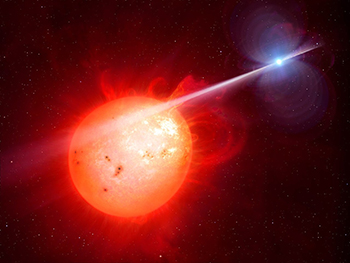
Earlier this year, a group of international astronomers
announced the discovery of an exotic binary star system,
AR Scorpii. The system is in the Scorpius constellation.
Photos: Supplied
See article on Nature’s website
In future, stargazers and astronomers will look at the Scorpius constellation near the Milky Way with new eyes. Earlier this year, a group of international astronomers announced the discovery of an exotic binary star system, AR Scorpii. The system is in the Scorpius constellation.
Prof Pieter Meintjes, researcher in the Department of Physics at the University of the Free State (UFS), worked with four colleagues on what he describes as a “wonderful discovery”. This sensational discovery, which could lead to the production of cleaner energy on Earth, will be published in the research journal, Nature, early in 2017.
Model developed to interpret new set of measurements
The exotic binary star which was discovered consists of a red dwarf and a white dwarf revolving around each other every 3,5 hours. The binary system showed very prominent pulsations of 117 and 118 seconds respectively. The pulsations can be explained by a bundle radiation produced by the white dwarf star.
“These new observations have shown that the radiation is strongly polarised, a sign that we are dealing with synchrotron radiation here. Synchrotron radiation is produced by electrons accelerated to extremely high energy levels in the magnetic field of the white dwarf star,” says Prof Meintjes.
He developed a theoretical model to interpret a new set of measurements that was taken by the 1,9 m telescope and the 10 m SALT telescope at the South African Astronomical Observatory (SAA0).
Totally unique phenomenon could contribute to energy production on Earth
“I further indicated that the interaction between the magnetic fields of the white dwarf star and the red dwarf star induces secondary processes that specifically describe the behaviour of the radiation in the radio band and infrared band accurately. AR Sco is the first white-red dwarf binary system of which all the pulsated radiation could be explained by the synchrotron process, which is totally unique,” says Prof Meintjes.
According to Prof Meintjes, the value of the model lies in the fact that the processes which produce the radiation in AR Sco, can also be applied to produce energy on Earth.
Plasma reactors are based on roughly the same processes which apply in AR Sco, and with refining, it could be utilised to generate electricity in future. This will be much cleaner than nuclear energy.
The model developed by Prof Meintjes explains all the radiation in the system – from radio waves to X-rays – in terms of electrons accelerated to extremely high energy levels by electric fields in the system, which then produce synchrotron radiation over a very wide band of the electromagnetic spectrum.
Prof Meintjes is currently working on a follow-up article examining the evolution of the AR Sco, in other words, the origin of such a unique system and the final state towards which it is evolving. “My vision for the immediate future is therefore to develop a model for the evolution of the source concerned,” he says.